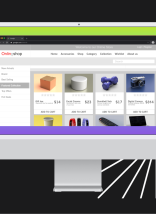Shopify provides the ability to have a fully functioning eCommerce website without having to do any coding or hosting.
Because it is a Saas offering, all you need to do is sign up for an account and start adding products to your store. It is very simple to use.
Some customizations are able to be made through its API and Liquid templating. While Shopify is not easily customized like Magento 2, it works well if you would like to start a small, simple store.
In what scenarios should you use Shopify?
You have a small product catalog.
Shopify is a great starting point for a business with a small number of products. It simply wouldn’t make sense to use a robust platform like Magento 2, which would include a large upfront investment and unnecessary features for inventory management.
eCommerce is not the main focus of your website.
If you would like a store in addition to your main website, Shopify is a simple way to do this. For example, many businesses need a side store to sell merchandise for the brand – like t-shirts, mugs, or stickers.
Because Shopify is a low time and monetary investment, it’s quick to see a return with this secondary revenue generator.
You need a quick proof of concept.
Many businesses wish to test selling some products before focusing on expansion. Due to the low cost barrier and how quickly a store can get running, Shopify can be a great way to dip your toes into having an eCommerce site without having to commit capital.
For those needing a store up right away, but still want the customization of Magento, a solution could be to have a store running in Shopify while the Magento 2 store is being built out. Once the Magento 2 store is complete, you can rely on a partner to help migrate the products.
There are little customization and integrations required.
If the eCommerce site requires very little customizations and very little integrations with other services, then Shopify becomes the obvious choice.
Shopify allows some customizations using its Liquid templating language. However, with the amount of effort it takes to truly customize Shopify themes, another option often makes more sense.
You’re on a tight budget.
If you are not willing to invest a lot of money upfront, Shopify will help you get going at a smaller cost. Because it is a Software as a Service (SaaS), you won’t have to worry about monthly hosting fees, maintenance/upgrades costs, and other expenses involved with using a platform like Magento 2.
Shopify does take a percentage of every sale, so as the store grows and does more business, the cost savings will lessen. At that point it’s time to consider migrating to something else.
You are mostly selling through third-party marketplaces.
Shopify has built-in support for various third-party marketplaces. Many storefronts are supported, including Amazon, Facebook, and Pinterest. If you’d like to mostly sell in these places, but also want a centralized place to maintain products and have some web presence, Shopify is the optimal solution.
In what scenarios should you not use Shopify?
You have a B2B store.
Most B2B stores require more integrations than B2C. Also, many require more advanced customer management such as login portals and history of past orders.
For these reasons, Shopify is rarely a good fit for B2B stores.
You have multiple websites.
If your setup includes multiple stores which share some products, Shopify does not offer a solution to handle this. In Shopify, you’d have to use multiple accounts for each store and consider each store its own entity.
Magento, on the other hand, supports multiple stores out of the box, enabling products to be shared across multiple stores and websites and to be managed from the same codebase.
You need multilingual support.
If your eCommerce website needs to be multilingual, it can be challenging to set up in Shopify. While there are apps on Shopify’s marketplace that offer this type of support, it is not built-in or easily managed.
You need extensive integrations.
Shopify provides a simple API that can be used for integrating the stores into different services, but for more extensive integrations it can become impossible.
A team experienced in many platforms can guide you.
Need help evaluating your situation and choosing the best eCommerce platform? Reach out for a free consultation with one of our experts. We’re happy to help you get started with your solution.










